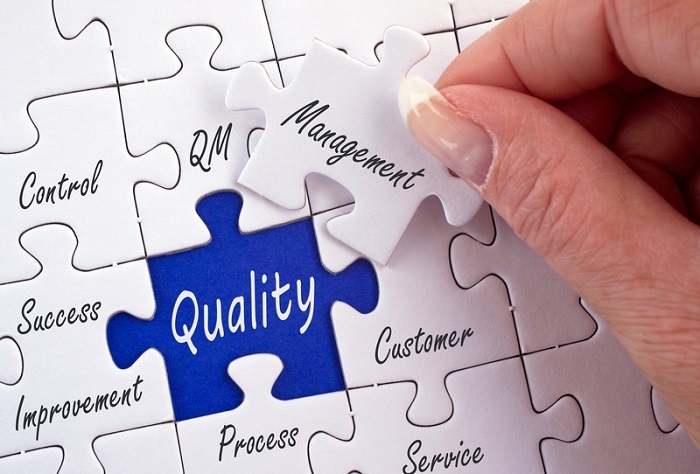
 Data Structure
Data Structure Networking
Networking RDBMS
RDBMS Operating System
Operating System Java
Java MS Excel
MS Excel iOS
iOS HTML
HTML CSS
CSS Android
Android Python
Python C Programming
C Programming C++
C++ C#
C# MongoDB
MongoDB MySQL
MySQL Javascript
Javascript PHP
PHP
- Selected Reading
- UPSC IAS Exams Notes
- Developer's Best Practices
- Questions and Answers
- Effective Resume Writing
- HR Interview Questions
- Computer Glossary
- Who is Who
How Does Quality Management Help in Managing Risks?
The success of any organization is dependent on effective quality and risk management. Quality management is concerned with meeting or exceeding customer expectations, whereas risk management is concerned with identifying, assessing, and managing potential threats to the organization's performance.

Quality and risk management are inextricably linked, as quality management can help mitigate risks and reduce the likelihood of negative outcomes, while risk management can help identify potential quality issues and prevent them from occurring.
This article covers various aspects of Quality management implementation in risk management, which can be challenging because it necessitates a shift from reactive problem-solving to proactive risk management, as well as improved coordination and communication between the two functions.
Introduction to Quality Management and Risk Management
Quality management is critical in risk management within an organization. Companies can identify and address potential risks before they become major issues by implementing effective quality management practices.
One study found that organizations with strong quality management systems had 46% fewer quality-related issues and saved an average of $16 million per year than those with weak or nonexistent quality management systems. This highlights the importance of investing in quality management to reduce risks and improve overall organizational performance.
Effective quality management includes establishing processes and procedures to ensure that products or services meet or exceed customer expectations. By focusing on quality, organizations can reduce the likelihood of defects, errors, and other issues that can lead to costly mistakes or legal liabilities.
Furthermore, quality management can help businesses identify and respond to risks such as supply chain disruptions, cybersecurity threats, and other outside factors. By continuously monitoring and improving quality, organizations can better anticipate and adapt to changing circumstances, ultimately improving their ability to manage risks and succeed in a competitive marketplace.
Understanding the Relationship Between Quality Management and Risk Management
Quality and risk management are two critical components to the success of any organization. While quality management focuses on ensuring that a product or service meets or exceeds customer expectations, risk management focuses on identifying, assessing, and managing potential threats to an organization's performance.

Quality management and risk management are inextricably linked concepts. When quality management is effective, it can help mitigate risks and reduce the likelihood of negative outcomes. Implementing quality control measures, for example, in a manufacturing process, can reduce the risk of defective products and recalls. Risk management, on the other hand, can help in identifying and preventing potential quality issues.
An American Society for Quality study found that organizations that place a strong emphasis on quality management are better equipped to manage risks. According to the study, companies that scored higher on quality measures had lower rates of noncompliance with regulations and standards, as well as fewer customer complaints and product recalls.
Benefits of Incorporating Quality Management in Risk Management Strategies
Incorporating quality management into risk management strategies can provide numerous benefits. Quality management helps businesses ensure that their products and services meet the needs of their customers while also meeting regulatory requirements. By doing so, organizations can reduce the likelihood of risks and improve their overall performance.
One statistic that supports this is that organizations with a strong quality management system have fewer quality issues, which results in lower costs and higher customer satisfaction. According to an American Society for Quality study, companies that invested in quality management saw a 45% reduction in defects and a 30% increase in customer satisfaction.
As a result, incorporating quality management practices into risk management strategies can be an effective way for organizations to manage risks and improve overall performance.
Quality Management Tools and Techniques for Risk Management
Quality management tools and techniques are critical in risk management in an organization. One statistic that highlights the importance of quality management in risk management is that companies that adopt quality management practices experience a 20-30% reduction in their overall business costs.
The FMEA (Failure Mode and Effects Analysis) technique is a key tool in quality management for risk management. This tool assists organizations in identifying potential failures and their consequences, as well as providing a structured approach to managing and mitigating those risks. Other quality management tools, such as statistical process control, root cause analysis, and control charts, assist organizations in identifying potential risks and taking proactive measures to mitigate them.
By implementing quality management tools and risk management techniques, organizations can reduce the likelihood of failure, improve product and service quality, and increase customer satisfaction. The organization's profitability and sustainability improve as a result.
Implementation of Quality Management in Risk Management: Best Practices
Quality management is a methodical approach to ensuring that products and services meet customers' expectations and needs. When it comes to risk management, quality management can help identify potential risks and implement risk mitigation measures.
Establishing a quality culture within the organization is one of the best practices for implementing quality management in risk management. This can be accomplished by involving all employees in the quality management process and providing quality management principles training.
An American Society for Quality study found that organizations that prioritize quality management have lower failure rates and higher customer satisfaction. This emphasizes the significance of implementing quality management practices in risk management.
Another best practice is to use quality management tools, such as Six Sigma or Lean management, to identify and eliminate waste, defects, and errors that may pose risks. These tools can assist in streamlining processes, lowering costs, and increasing efficiency, lowering the likelihood of risks occurring.
Challenges in Implementing Quality Management in Risk Management
Implementing Quality Management in Risk Management can be a difficult task for businesses. One statistic that highlights this challenge is that only 54% of organizations reported being effective at risk management in a study conducted by the Project Management Institute.
One of the difficulties in implementing Quality Management in Risk Management is that it necessitates a mental shift from reactive problem-solving to proactive risk management. This means that businesses must be more proactive in identifying and mitigating potential risks before they become major issues.
Another issue is that Quality Management and Risk Management are frequently viewed as distinct functions within an organization. This can result in a lack of coordination and communication between these two functions, leading to missed opportunities to identify and manage risks.
To overcome these obstacles, organizations must integrate Quality Management and Risk Management into their overall business strategy. This entails fostering a risk-management culture in which everyone in the organization understands the importance of risk management and actively participates in identifying and mitigating potential risks.

